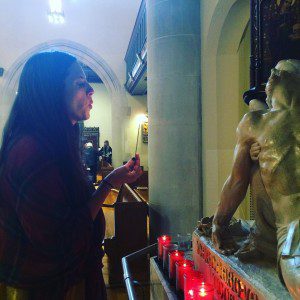
An article in The Atlantic grabbed our attention last week–about young Jews embracing the more traditional practices their parents had rejected. We completely identified. The return to traditional faith practices–what the Catholic Church refers to as “popular piety”– played a significant role in both of our returns to Catholicism, the religion our parents had abandoned.
Our families had been Catholic for generations. Jess’s parents were old school cultural Catholics from New Orleans–they went to Mass and prayed the rosary but they also threw salt over their shoulders and crossed themselves when they saw a black cat. Jonathan’s parents got caught up in the Catholic Charismatic movement in the 70s. He remembers going to masses where nuns and priests spoke in tongues, danced in the aisles and prophesied. Quite a sight.
Much of that charismatic fervor was fueled by the Baby Boomer, Vatican II generation. They threw many of the old school Catholic practices–the stuff Jess was raised with–out with the bath water in the name of “modernization.” They were trying to be “relevant,” that word we despise so much today. Left and right, the movement to dispose of the obviously foreign, the un-American, the embarrassingly Catholic ways swept both sides of the church. We all became kinda protestant.
It’s understandable. Catholicism before Vatican II needed a serious overhaul. But whether out of embarrassment or outright derision, we lost our Popular Piety–the practices that distinguished us as Catholics, the stuff that made us look weird. When Jess moved away from New Orleans and Pittsburgh–both old-world, ethnic Catholic cultures that clung to the old ways–she no longer recognized her church. The Catholic churches were indistinguishable from the Protestant mega-churches. She found herself wondering why on earth she’d continue to wrestle with this archaic, Problematic with a capital P faith if there was no more smells, bells, and magic? She needed those things to imagine herself in divine love.
That kind of Catholic distinctiveness is attracting Millennials, and Jonathan, as a former Presbyterian minister, thinks it’s because millennials don’t really want that mega-church style. They’re looking for something more, something that marks them as different, something they can’t find in secular culture. They’re rebelling against the changes our grandparents rebelled to make. As The Atlantic pointed out about Millennial Jews, “They want connection, boundaries and authenticity.” Or as the American Conservative noted of Millennial Anglican converts, they “ache for sacramentality.” They’ve had the luxury of forgetting (or never knowing) the very real oppression and misogyny and corruption and on and on, and now they want some of that good old fashioned Catholic magic.
Working at Notre Dame, Jonathan tries to attend mass at the Basilica of the Sacred Heart at least once a week. He noticed how many of the younger women have started to use prayer shawls to cover their heads–mantillas. Another Catholic practice that went out with Vatican II. While he marveled at this with one of his Baby Boomer/Gen-X friends, she was appalled: “Don’t they know that’s a sign of oppressing women?” But when Jonathan asked one of the women after the service, she only looked puzzled. “Uh, is it really? I just know it focuses my attention on God and helps me to pray.”
The official Vatican Directory on Popular Piety defines these practices as “diverse cultic expressions of a private or community nature which, in the context of the Christian faith, are inspired predominantly not by the Sacred Liturgy but by forms deriving from a particular nation or people or from their culture.” It’s the Catholicism of your neighborhood, your hometown, your ethnicity. It’s what marked American Catholics as immigrants and outsiders. The Vatican document goes on to call it “a treasure of the people of God” that “generates interior attitudes otherwise rarely seen to the same degree: patience, an awareness of the Cross in every-day life, detachment, openness to others and devotion.”
Wearing a mantilla is an expression of piety, and it’s one of those distinctively Catholic things that attracts people and/or repels people from the Church. So is praying to Saint Anthony to find something you lost. So is making a Saint Joseph’s Altar on his feast day. Or making soul cakes on All Hallow’s Eve. Walking in a corpus Christi procession or a Santa Lucia parade. Eating Paczkis or king cakes on Fat Tuesday. The list is endless (see the Vatican document for dozens of examples), and we each have our favorites. Are they necessary for our salvation? Hell no. But these are the things we, Jonathan and Jess, miss when we try to worship somewhere else. These–along with the sacred liturgy–are the things that draw us back to a quest for holiness, to a longing for Jesus.
For the next few weeks, we want to explore the physicality and the magic of traditional Catholicism here at Sick Pilgrim, because we suspect it’s what many of us are after. We want to hear and tell stories that reveal the power and beauty of ancient Catholic practices in real life—as clumsy and imperfectly realized as they may be. We hope these stories will encourage delight and comfort in the distinctive (and peculiar) ways Catholics have lived their faith in many disparate traditions and locations. We want to hear and talk about what’s not so beautiful too–what is ugly, creepy, sexist, offensive, or just silly. There are plenty of ancient pious practices that we aren’t itching to revive.
We at Sick Pilgrim are magical Catholics. Jonathan makes Icons based on New Mexican folk art and once had a vision of the Sacred Heart (lucky!). Jess never met a ritual she didn’t love, and she’s superstitious as hell and once made her daughter dip a voodoo doll key chain (a present from her less jumpy aunt) in a font of holy water. We love the physicality of the sacraments and sacramentals, we light candles at roadside shrines, and we’re always looking for a hidden house of the holy.
But for this new series, and we hope, for the benefit of our souls, we’re going to up the ante.
We’re starting small: We’re going to pray a novena to the Immaculate Heart of Mary. Novenas are not uncommon in today’s Catholic world, though they are decidedly old-fashioned. But since we both have hangups about Marian devotion, this will be a challenge for us. Jess has also challenged Jonathan to make a hair shirt and wear it to work, and she’s thinking of walking barefoot to confession as a sign of public penance like Kristin Lavransdatter. Matt’s going to write about a traiteur–an old school Cajun Catholic faith healer.
We don’t just want these to be stunts, or some kind of gimmicky project. We are hungry for real-life experiences of the sacraments, sacramentals, and the often obscure, sometimes embarrassing, and all-together forgotten Catholic customs that formed and sustained the faith of so many before us. We’re setting out to raid the church for treasures. Maybe we’ll bring some Catholic magic back.
Onward, pilgrims!
Jonathan & Jess











